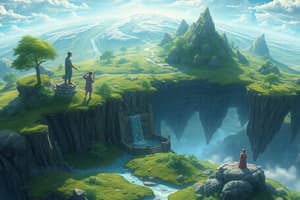Podcast
Questions and Answers
Which sphere of Earth primarily consists of water in various forms?
Which sphere of Earth primarily consists of water in various forms?
- Atmosphere
- Biosphere
- Cryosphere
- Hydrosphere (correct)
What process describes the movement of water through the atmosphere, land, and bodies of water?
What process describes the movement of water through the atmosphere, land, and bodies of water?
- Carbon cycle
- Nitrogen cycle
- Hydrologic cycle (correct)
- Soil formation
Which sphere involves the interaction of living organisms with the components of Earth?
Which sphere involves the interaction of living organisms with the components of Earth?
- Magnetosphere
- Biosphere (correct)
- Atmosphere
- Geosphere
Which cycle is crucial for the transformation of atmospheric nitrogen into a usable form for plants?
Which cycle is crucial for the transformation of atmospheric nitrogen into a usable form for plants?
What sphere of Earth is primarily involved in magnetic interactions and protects the planet from solar radiation?
What sphere of Earth is primarily involved in magnetic interactions and protects the planet from solar radiation?
What effect does soil degradation have on land use?
What effect does soil degradation have on land use?
Which of the following soil orders is typically found in humid, forested regions?
Which of the following soil orders is typically found in humid, forested regions?
In the context of land conversion, which factor most significantly influences the shift from agricultural to urban land use?
In the context of land conversion, which factor most significantly influences the shift from agricultural to urban land use?
Which of the following is a characteristic of Histosols?
Which of the following is a characteristic of Histosols?
What is a common consequence of converting agricultural land to real estate development?
What is a common consequence of converting agricultural land to real estate development?
Flashcards are hidden until you start studying
Study Notes
Earth's Spheres
- The Earth consists of several interconnected spheres: Atmosphere, Geosphere, Hydrosphere, Biosphere, Cryosphere, Magnetosphere and Anthrosphere.
Soil Processes: Cycles
- Hydrologic Cycle: The continuous movement of water on, above and below the surface of the Earth.
- Nitrogen Cycle: The process of converting atmospheric nitrogen (N2) into usable forms for plants and animals, and back again.
- Carbon Cycle: The circulation of carbon throughout the Earth's systems, including the atmosphere, oceans, land, and living things.
Soil Types
- Soil type depends on a variety of factors, including climate, parent material, topography, organisms, and time.
- Common soil types include: sandy, loamy, and clay soils.
Soil Formation
- Soil forms from the weathering of rocks.
- This involves physical, chemical and biological processes that break down rocks into smaller particles.
- These processes can take hundreds or thousands of years.
Soil Horizons
- The layers of soil that form from weathering and other processes are called horizons.
- Each horizon has a distinct texture, color, and chemical composition.
- Horizons are commonly referred to as O, A, E, B, C and R.
Soil Degradation
- Soil degradation is the decline of the soil's quality.
- It can be caused by a variety of factors, including:
- Deforestation
- Overgrazing
- Pollution
- Climate change
- Urban sprawl
Soil Orders
- 12 distinct soil orders are recognized:
- Andisols: Young, volcanic soils.
- Aridisols: Dry soils found in desert regions.
- Entisols: Young soils with minimal development.
- Gelisols: Permafrost soils found in cold regions.
- Histosols: Organic soils formed from decaying plant matter, called peat.
- Inceptisols: Soils that have begun to develop horizons but are not yet mature.
- Mollisols: Deep, dark soils found in grasslands.
- Oxisols: Heavily weathered soils found in tropical regions.
- Spodosols: Soils that are acidic and have a distinct layer of organic matter.
- Ultisols: Highly weathered soils with low fertility.
- Vertisols: Clayey soils that shrink and swell with changes in moisture.
- Alfisols: Moderately weathered soils, rich in nutrients.
Studying That Suits You
Use AI to generate personalized quizzes and flashcards to suit your learning preferences.




